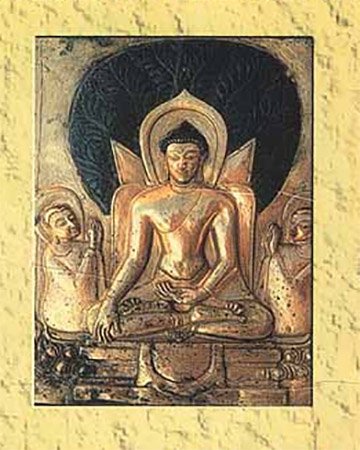The Mahavastu (great story)
by J. J. Jones | 1949 | 502,133 words | ISBN-10: 086013041X
This page describes titans (asura) which is Chapter III-c of the English translation of the Mahavastu (“great story”), dating to the 2nd-century BC. This work belongs to the Mahasanghika school of early Buddhism and contains narrative stories of the Buddha’s former lives, such as Apadanas, Jatakas and more..
Chapter III-c - Visit to other worlds (3): Titans (asura)
(30) The venerable Mahā-Maudgalyāyana often went on a visit to the Asuras.[1] In their citadel he saw Asuras of gigantic size, of frightful aspect and of great malevolence, beings who at death had fallen down in ruin to the world of the Asuras. The venerable elder Kolita as he went on his way among the Asuras, saw five classes of Asuras greatly tormented by their envy of the Suras.[2]
This is the burden of their thought: “We are down below, the devas are up above.” Hence they are aggrieved, jealous, brimming over with rage, fury, and desperation, nor do they conceal it. Equipping a mighty force of four arms, namely, fighters on elephants, cavalry, charioteers, and infantry, they break up the ranks of the devas, namely, the Karoṭapāṇi Yakṣas, the Mālādhāra Yakṣas, and the Sadāmatta Yakṣas.[3]
Then when they have broken these ranks they join battle with the Trāyastriṃśa[4] devas, but after they have betrayed their evil disposition towards the Trāyastriṃśa devas, who are meritorious and powerful, the Asuras, after the dissolution of the body at death, are reborn in woe, evil plight, ruin, in hell.
When Mahā-Maudgalyāyana had seen the great misery of the Asuras, he came to the Jeta Grove and described it in detail to the four assemblies. “Thus,” said he, “do beings in Mahāsamudra, the abode of the Asuras, suffer manifold miseries. Therefore, we ought to strive after knowledge, win it, be enlightened, be fully enlightened, live the holy life and commit no sin in this world. Thus I declare.”
When they heard the elder, many thousands of devas and men won immortality.
Footnotes and references:
[1]:
The Giants or Titans of Indian mythology; in Buddhist literature they are classed as inferior devas. Rebirth as an Asura was considered one of the four unhappy births. Cf. note p. 36.
[2]:
See p. 56.
[3]:
The Yakṣas were, roughly speaking, the spirits that, in popular belief, haunted the woodland and watery depths. These three classes of Yakṣas supported the devas in their fight with the Asuras. The first are evidently the Karoṭi of the Pali texts, but the other two do not seem to be named elsewhere.
[4]:
Pali Tāvatiṃsa, the second of the six deva-worlds, and the home of the “Thirty-three devas,” ruled by Śakra or Indra. The number thirty-three is conventional, and the Commentaries say that this heaven was so named after Magha, a previous birth of Śakra, and his thirty-two companions who were reborn there. (See D.P.N.)
